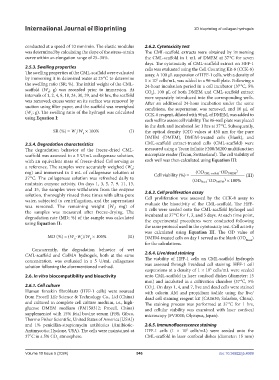Page 554 - IJB-10-5
P. 554
International Journal of Bioprinting 3D bioprinting of collagen hydrogels
conducted at a speed of 10 mm/min. The elastic modulus 2.6.2. Cytotoxicity test
was determined by calculating the slope of the stress–strain The CML-scaffold extracts were obtained by immersing
curve within an elongation range of 25–30%. the CML-scaffold in 1 mL of DMEM at 37 °C for seven
days. The cytotoxicity of CML-scaffold extract on HFF-1
2.5.3. Swelling properties cells was evaluated using the Cell Counting Kit-8 (CCK-8)
The swelling properties of the CML-scaffold were evaluated assay. A 100 μL suspension of HFF-1 cells, with a density of
by immersing it in deionized water at 25 °C to determine 1 × 10 cells/mL, was added to a 96-well plate. Following a
5
the swelling ratio (SR; %). The initial weight of the CML- 24-hour incubation period in a cell incubator (37 °C, 5%
scaffold (W ; g) was recorded prior to immersion. At CO ), 100 μL of both DMEM and CML-scaffold extract
0
2
intervals of 1, 2, 4, 8, 18, 24, 30, 39, and 48 hrs, the scaffold were separately introduced into the corresponding wells.
was removed; excess water on its surface was removed by After an additional 24-hour incubation under the same
suction using filter paper, and the scaffold was reweighed conditions, the supernatant was removed, and 10 μL of
(W ; g). The swelling ratio of the hydrogel was calculated CCK-8 reagent, diluted with 90 μL of DMEM, was added to
1
using Equation I: each well to assess cell viability. The 96-well plate was placed
in the dark and incubated for 1 hrs at 37 °C. Subsequently,
SR (%) = W /W × 100% (I) the optical density (OD) values at 450 nm for the pure
1
0
DMEM (DMEM), DMEM-treated cells (Blank), and
2.5.4. Degradation characteristics CML-scaffold extract-treated cells (CML-scaffold) were
The degradation behavior of the freeze-dried CML- measured using a Tecan Infinite F200/M200 multifunction
scaffold was assessed in a 5 U/mL collagenase solution, microplate reader (Tecan, Switzerland). The cell viability of
with an equivalent mass of freeze-dried Col serving as each well was then calculated using Equation III:
a reference. The samples were accurately weighed (W ;
0
-
mg) and immersed in 1 mL of collagenase solution at Cell viability (%) = (OD CML-scaffold OD DMEM ) (III)
37 °C. The collagenase solution was refreshed daily to (OD Blank OD DMEM × 100%
)
-
maintain enzyme activity. On days 1, 3, 5, 7, 9, 11, 13,
and 15, the samples were withdrawn from the enzyme 2.6.3. Cell proliferation assay
solution, thoroughly rinsed three times with ultra-pure Cell proliferation was assessed by the CCK-8 assay to
water, subjected to centrifugation, and the supernatant evaluate the bioactivity of the CML-scaffold. The HFF-
was removed. The remaining weight (W ; mg) of 1 cells were seeded onto the CML-scaffold hydrogel and
t
the samples was measured after freeze-drying. The incubated at 37 °C for 1, 3, and 5 days. At each time point,
degradation rate (MD; %) of the sample was calculated
using Equation II: the experimental procedures were conducted following
the same protocol used in the cytotoxicity test. Cell activity
was calculated using Equation III. The OD value of
MD (%) = (W -W )/W × 100% (II) DMEM-treated cells on day 1 served as the blank (OD )
0
0
t
for the calculations. Blank
Concurrently, the degradation behavior of wet
CML-scaffold and ColMA hydrogels, both at the same 2.6.4. Live/dead staining
concentration, was evaluated in a 5 U/mL collagenase The viability of HFF-1 cells on CML-scaffold hydrogels
solution following the aforementioned method. was assessed through live/dead cell staining. HFF-1 cell
suspensions at a density of 1 × 10 cells/mL were seeded
5
2.6. In vitro biocompatibility and bioactivity onto CML-scaffold in laser confocal dishes (diameter: 15
mm) and incubated in a cultivation chamber (37 °C, 5%
2.6.1. Cell culture CO ). On days 1, 4, and 7, live and dead cells were stained
2
Human foreskin fibroblasts (HFF-1 cells) were sourced with calcein AM and propidium iodide using the live/
from Procell Life Science & Technology Co., Ltd (China) dead cell staining reagent kit (CA1630; Solarbio, China).
and cultured in complete cell culture medium, i.e., high- The staining process was performed at 37 °C for 1 hrs,
glucose DMEM medium (PM150312; Procell, China) and cellular viability was examined with laser confocal
supplemented with 15% fetal bovine serum (FBS; Gibco, microscopy (FV3000; Olympus, Japan).
Thermo Fisher Scientific, United States of America [USA])
and 1% penicillin-streptomycin antibiotics (Antibiotic- 2.6.5. Immunofluorescence staining
Antimycotic; Hyclone, USA). The cells were maintained at HFF-1 cells (1 × 10 cells/mL) were seeded onto the
5
37˚C in a 5% CO atmosphere. CML-scaffold in laser confocal dishes (diameter: 15 mm)
2
Volume 10 Issue 5 (2024) 546 doi: 10.36922/ijb.4069

